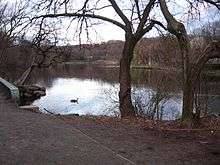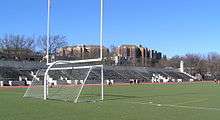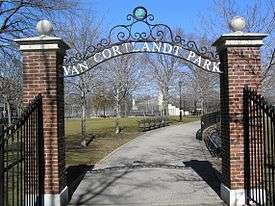Van Cortlandt Park
| Van Cortlandt Park | |
|---|---|
|
Entrance to Van Cortlandt Park | |
  | |
| Type | Municipal |
| Location | The Bronx, New York City, NY, US |
| Coordinates | 40°53′52″N 73°53′02″W / 40.8978°N 73.8839°W |
| Area | 1,146 acres (464 ha) |
| Created | 1888 |
| Operated by | Van Cortlandt Park Conservancy |
| Public transit access |
New York City Subway: Woodlawn (4) and Van Cortlandt Park – 242nd Street (1) stations New York City Bus: Bx9, Bx10, Bx16, Bx34 local buses, BxM3, BxM4 express buses Bee-Line Bus System: B-L1, B-L2, B-L3, B-L4, B-L20, B-L21 |
Van Cortlandt Park is a 1,146-acre (464 ha) park located in the borough of the Bronx in New York City. It is the third largest park in New York City, behind Pelham Bay Park and Staten Island Greenbelt. The park was named for Stephanus Van Cortlandt, who was the first native-born mayor of New York, and the Van Cortlandt family, which was prominent in the area during the Dutch and English colonial periods. Contained within the park is the Van Cortlandt House Museum, the oldest building in the Bronx. The park is owned by the New York City Department of Parks and Recreation and managed with assistance from the Van Cortlandt Park Conservancy, a private non-profit organization founded in 2009, and the Friends of Van Cortlandt Park, an independent non-profit established in 1992.
There are two nearby New York City Subway stations. The eastern side of the park is served by the Woodlawn subway station (4 train), and the western side by 242nd Street subway station (1 train).
Van Cortlandt Park contains New York City's largest freshwater lake.[1]
History
.jpg)
The Wiechquaskeck Lenapes were among the first recorded people to settle in the area now referred to as Van Cortlandt Park. The Lenapes used the geographic features of the area, such as the Tibbetts Brook for fishing and flatland areas for farming, to support their community.[2] The land that Van Cortlandt Park now occupies was purchased by Jacobus Van Cortlandt from John Barrett around 1691. Passed on to his son Frederick Van Cortlandt (1699–1749) and family, it was once a vast grain plantation. In 1748, Frederick built what is now known as the Van Cortlandt House on the property, but died before its completion. Frederick willed the massive home and surrounding lands to his son, James Van Cortlandt (1727–1787).
The Van Cortlandt family land was used during the Revolutionary War by Rochambeau, Lafayette, and Washington. It was in this area that the Stockbridge militia was destroyed by the Queen's Rangers; a stone memorial was placed at "Indian Field" in 1906.[3]
In 1888, the family property was sold to the City of New York and made into a public parkland, with the majority of the grain fields converted into a sprawling lawn dubbed "The Parade Ground". The Van Cortlandt House was converted into a public museum and, with the city's approval, particularly overgrown areas of the property were made passable. Wide walking paths were built over original walkways, including the thin paths that led to the Van Cortlandt family cemetery, high on the nearby bluffs.

On July 13, 1905, Isaac Mackie won an Open Tournament at the Van Cortlandt Park golf links by shooting 152 on a course that had been soaked with rain. He held off joint second-place finishers Willie Anderson and Bernard Nicholls who finished on 157. It was the first ever professional tournament held on a public links golf course in the United States.[4]
In 1907, due to overcrowding, Dr. William Hornaday transferred several of the Bronx Zoo's then-rare bison to Van Cortlandt Park's parade grounds. Later that year, they were shipped to prairie land in Oklahoma.[5]
Robert Moses's development plans in the 1930s called for the construction of the Henry Hudson Parkway and Mosholu Parkway to bisect Van Cortlandt Park and meet at a cloverleaf interchange about half a mile north of the center. The last remaining freshwater marsh in New York City was dredged and landscaped to accommodate construction.
The Van Cortlandt House was added to the National Register of Historic Places in 1967 and became a National Historic Landmark in 1976.[6][7]
The city's fiscal crisis in the 1970s caused much of the park to fall into disrepair. Gradual improvements began taking place from the late 1980s through the mid-2000s, including the addition of new pathways, signage, and security.
Attractions

Van Cortlandt Park has numerous attractions and features that are both recreational and educational. The park is home to a free public pool, along with numerous playgrounds for children and areas dedicated for barbecuing. Van Cortldant Park also contains many areas dedicated to various sports, including baseball, basketball, soccer, cricket, ice skating, and fishing.[8] The Van Cortlandt Golf Course, the nation's first public golf course,[1] opened in 1895 and is located centrally on the park grounds. The "Parade Ground" north of the museum in the western part of the park is one of New York's principal cricket fields. The Putnam Trail, an unpaved trail, runs north through the woods to the east of this lawn and west of Van Cortlandt Lake, through the golf course and along Tibbets Brook and the former New York and Putnam Railroad line into Yonkers where it connects to Westchester County's paved South County Trailway. Another bikeway runs east from the golf course's clubhouse to connect to the Mosholu Parkway bike path. The Old Croton Aqueduct Trailway begins in Van Cortlandt Park.
The historic house located in the southern part of Van Cortlandt Park was erected by Frederick Van Cortlandt in 1748. The estate the house sits on was of major importance during the American Revolution. Troops from both the British and Colonial American army rested in this house during the time of war. The Van Cortlandt family owned the property until they decided to sell both the house and land to the City of New York in 1886. Ten years later, the house was restored as a museum displaying the cultural and lifestyle of families in the 18th century.[9]
Van Cortlandt Park is a popular site for cross country running owing to its miles of cinder trails and hills. The path surrounding the Parade Grounds, known to runners as the "flats", is 1.37 miles (2.20 km) around. The "back hills" provide a 1.3-mile (2.1 km) loop in the northwestern section of the park. Some trail sections are a part of the East Coast Greenway, a 3,000-mile-long (4,800 km) trail system connecting Maine to Florida. The park was used for the Northeast regional championships of the Foot Locker Cross-Country Championships until 2009[10] and is used as numerous college championships each fall. The 2.5-mile (4.0 km) course is used for most high school races, including the Manhattan College Invitational, one of the largest high school cross-country meets in the nation. In 2006, the USA Cross-Country Championships were held at Van Cortlandt and organized by USATF and New York Road Runners. Van Cortlandt Park is also used for many college races and is the home course for Fordham University, Iona College, New York University and Manhattan College (which is located right across the street). The college course is five miles (8.0 km) long. It is used annually for the ICAAAA championships and has hosted the NCAA championships on numerous occasions (attendance about 10,000). It is the home course for the Van Cortlandt Track Club, which started in the late 1970s as a small group of runners meeting for jaunts around the Jerome Park Reservoir in the Bronx.
The park is the former home of the Manhattan College Jaspers college baseball team. For the 2015 season, the Jaspers moved to Dutchess Stadium.[11]
In popular culture
- In Philip Kaufman's film The Wanderers (1979), a football game between The Wanderers and rivals the Del Bombers was filmed at Van Cortland Park.
- In Sol Yurick's book The Warriors (1965), the meeting called by Ismael Rivera, leader of the Delancey Thrones, takes place in Van Cortlandt Park. In the 1979 film adaptation of Yorick's novel, one of the gangs named by Cyrus is called "The Van Cortlandt Rangers".
- Van Cortlandt Park was referenced in José Rivera's play Marisol as a place where neo-Nazis burn homeless people alive in the apocalyptic world of the play.
- In the Seinfeld episode "The Big Salad" (season 6, episode 2), Kramer plays golf at the Van Cortlandt Park Golf Course with ex-Major League Baseball player Steve Gendason.
- Van Cortland Park is the place of many happy memories of Horse Badorties, protagonist of William Kotzwinkle's 1974 book The Fan Man.
References
- 1 2 "Van Cortlandt Park : NYC Parks". New York City Department of Parks & Recreation. Retrieved September 30, 2016.
- ↑ "History". Van Cortlandt Park Conservancy. Retrieved September 30, 2015.
- ↑ "Indian Field". New York City Department of Parks & Recreation. Archived from the original on May 16, 2008. Retrieved September 30, 2016.
- ↑ "Professional Golfers: Caddy Graduate Led a Field of Fifty-Two Players". Evening Star. Washington, D.C. July 14, 1905. Retrieved August 25, 2015.
- ↑ "Van Cortlandt Park". Forgotten New York. Retrieved January 27, 2009.
- ↑ Van Courland House National Park Service
- ↑ National Historic Landmark Survey, New York, retrieved June 3, 2007.
- ↑ "Features". Van Cortlandt Park Conservancy. Retrieved September 30, 2016.
- ↑ "The Historic House Trust of New York City: Van Cortlandt House".
- ↑ Foot Locker Cross-Country Home Page, viewed Nov. 9, 2009.
- ↑ Van Cortlandt Park at gojaspers.com, URL accessed November 15, 2009. Archived 11/15/09
External links
- New York City Department of Parks and Recreation VCP page
- Friends of Van Cortlandt Park
- Van Cortlandt Park Conservancy
- Van Cortlandt Track Club
Coordinates: 40°53′52″N 73°53′02″W / 40.8978°N 73.8839°W



